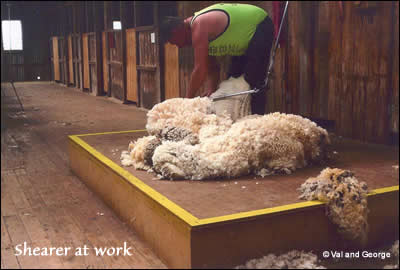The Australian wool industry began in 1797 with the introduction of Merino sheep to the colony of New South Wales, and within 50 years wool was Australia’s main export. For the continuing 100 years, wool exports were crucial to Australia’s economic prosperity, giving rise to the saying that, “Australia rode on the sheep’s back”.

On a trip to Hay in NSW recently, we visited ‘Shear Outback’, which gives visitors the history of, and an insight into, shearing. Shearers are a breed on their own – working 8 hours a day in 4 x 2hour shifts, shearing a sheep every 3 minutes. Back breaking work indeed, and they rely heavily on a good shearers’ cook to provide them with the food they need to keep them going: A large breakfast, sandwiches for morning tea, a big meal at lunchtime and cakes, biscuits and slices for afternoon tea, with an even larger evening meal of course. Shearers have been known to go on strike if the cook didn’t come up to expectations.
Australian bush poem, ‘Click Go The Shears, Boys’
In the early days they would travel overland from station to station on foot or by bike. The bikes were different from the norm, as, instead of tyres, they used thick rope around the rim to avoid punctures from the rough ground they had to travel over.

The shearers themselves devised a sling to hang from the rafters which would support their weight as they worked, thus minimising some of the terrible damage incurred to their backs whilst manipulating a heavy and wriggling sheep.
Each weekend, if they were close enough, the shearers would try to make it back home to their families. Time spent with their families was precious but, too often, the shearer’s wife’s lament became the all too familiar, and now famous:- “Friday – too tired, Saturday – too drunk, Sunday – too far away’. ‘Sunday too far away’ being the title of the film made of the Shearers’ strike.
We read about the famous shearer, Jackie Howe, who set an amazing record in 1892, shearing a total of 321 sheep in 7 hours and 40 minutes using hand blades. Jackie had enormous hands which enabled him to hold the shears quite comfortably and gave him the edge over other shearers. In the week beforehand Howe had set a weekly record, shearing 1,437 sheep in 44 hours and 30 minutes – a record which stood until well after machine shears were being used. The navy blue singlet top favoured by shearers for comfort and ease whilst shearing was given the name of ‘A Jackie Howe’ after one was worn by Jackie on the day he set the record.
Jackie was a committed trade unionist and was active in the shearers’ strikes of 1891 and 1894. There is a bronze statue of him in the town of Blackall in Queensland, which is the home of trade unionism in Australia.

He was born in Killarney near Warwick in Queensland. His Dad, Jack, had also been a shearer and had earned himself a reputation when he overlanded 9 llamas from Sydney to the Darling Downs in 1857, where he demonstrated shearing them. The llama’s reaction was to spit in his hair, an action that is still celebrated in Queensland folklore today. Jackie Howe died in 1920 in Blackall – a true champion of shearers’ rights and conditions.
We wandered down to the shearing shed for a demonstration and met the shearer. He was wearing a pair of moccasins on his feet and explained that they are lightweight, and made of felt which grip the wooden floor well and absorb sweat. The fastening arrangement prevent the shearer’s shears from catching in the laces and causing an accident. They are worn by a majority of shearers.
He told us that we were fortunate, as a sheep had been brought in the day before that had been running with a neighbour’s cattle for the past couple of years. It had escaped from the flock just before the last season’s shearing, so hadn’t been shorn for 2 years and it’s fleece was long and heavy and almost covered its eyes. The shearer carefully took 14 kgs of fleece from the animal and the relief it must have felt at having that weight taken from its back must have been immense. The sheep had trouble finding its feet again as it was so off balance, and was to be kept in the sheds for the next 24 hours to give it time to acclimatise before being put back in the paddock. This particular fleece will be popular with local spinners, as it is so long, and will be ideal for spinning.
Val and George
© Val and George 2009
Sources and Further Reading
Personal notes from visit to Shear Outback